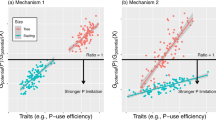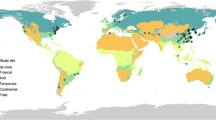Summary
Vegetation of the Mendocino coastal region forms a gradient from coastal redwood (Sequoia sempervirens) stands, through Bishop pine (Pinus muricata), to endemic pygmy conifers (Pinus contorta ssp.bolanderi, Cupresses pygmaca) on terrace flat/podzols. Along this gradient nutrient stocks and net uptake decrease, and strategies for rapid nutrient circulation within the ecosystems are increasingly in evidence. Within the pygmy conifer forest, the dominant plant species exhibit differing characteristics in their pattern of net uptake, partition and turnover or recirculation of each essential element. ‘The pygmy forest nutrient pool has apparently been built up over centuries by soil weathering, N-fixation by lichens, and inputs from precipitation. Such an ecosystem would be likely to show weak’ resilience to a perturbation that removed standing vegetattion or the litter layer. Across a wide range of terrestrial ecosystems, the ratio of plant nutrient stocks to phytomass tends to decrease with increase in phytomass and net primary productivity. This trend is reflected on a smaller scale by the decrease in nutrient phytomass ratio from pygmy forest, through Bishop pine, to redwood stands (0.013, 0.009, 0.006 respectively). Nevertheless, terrestrial communities in the temperate and subtropical regions of moderate rainfall and non-saline soils appear to share a relatively constant nutrient/phytomass concentration (mean ±s.e.=0.101±0.0003; n=9).
Similar content being viewed by others
References
AllenS.E., A.Carlisle, E.J.White & C.C.Evans. 1968. The plant nutrient content of rainwater. J. Ecol. 56: 497–504.
ArtH.W., F.H.Bormann, G.K.Voigt & G.M.Woodwell. 1974. Barrier Island forest ecosystem: role of meteorologic nutrient inputs. Science 184: 60–62.
AzevedoJ. & D.L.Morgan. 1974. Fog precipitation in coastal California forests. Ecology 55: 1135–1141.
Ballinger, W.E. 1957. Nutritional conditions of Michigan blueberry plantations. Ph.D. theis, Michigan State University, East Lansing.
CainJ.C. 1952. A comparison of ammonium and nitrate nitrogen for blueberries. Proc. Amer. Soc. Hort. Sci. 59: 161–166.
ClaytonJ.L. 1972. Salt spray and mineral cycling in two California coastal ecosystems. Ecology 53: 74–81.
ColeD.W., S.P.Gessel & S.F.Dice. 1967. Distribution and cycling of nitrogen, phosphorus, potassium and calcium in a second-growth Douglas-Fir ecosystem. In: H.E.Young (ed.), Symp. Primary Productivity and Mineral Cycling in Natural Ecosystems, pp. 197–232. University of Maine Press, Orono.
DavyA.J. & K.Taylor. 1974. Seasonal patterns of nitrogen availability in contrasting soils in the Chiltern Hills. J. Ecol. 62: 793–807.
DijkshoornW. 1969. The relation of growth to the chief ionic constituents of the plant. In: I.H.Rorison (ed.), Ecological Aspects of the Mineral Nutrition of Plants, pp. 201–213. Blackwell Scientific Publications, Oxford.
ErikssonE. (1952). Composition of atmospheric precipitation. II. Sulfur, chloride, iodine compounds, bibliography. Tellus 4: 280–303.
GardnerR.A. 1958. Soil-vegetation associations in the redwood Douglas-Fir zone of California. First North American Forest Soils Conference, pp. 86–101. Agricultural Experiment Station, Michigan State University, East Lansing.
Gardner, R.A. 1967. Sequence of podzolic soils along the coast of northern California. Ph.D. thesis, University of California, Berkeley. 226 pp.
GardnerR.A. & K.E.Bradshaw. 1954. Characteristics and vegetation relationships of some podzolic soils near the coast of northern California. Proc. Soil Sci. Soc. Am. 18: 320–325.
GolleyF.B., J.T.McGinnis, R.G.Clements, I.Child & M.J.Deuver, 1975. Mineral Cycling in a Tropical Moist Forest Ecosystem. University of Georgia Press, Athens. 248 pp.
JacksonM.L. 1958. Soil chemical analysis. Prentice-Hall, Englewood Cliffs, N.J. 498 pp.
JennyH., R.J.Arkley & A.M.Schultz. 1969. The pygmy forestpodsol ecosystem and its dune associates of the Mendocino coast. Madroño 20: 60–74.
JordanC.F., J.R.Kline & D.S.Sasser. 1973. A simple model of strontium and manganese dynamics in a tropical rain forest. Health Phys. 24: 477–489.
KingN.K. & R.G.Vines. 1969 Variation in the flammability of the leaves of some Australian species. C.S.I.R.O. Australia, Division of Applied Chemistry, Report. C.S.I.R.O., Melbourne.
LutzH.J. & R.F.Chandler. 1946. Forest Soils. J. Wiley & Sons: New York. 514 pp.
MattsonW.J. & N.D.Addy. 1975. Phytophagous insects as regulators of forest primary production. Science 190: 515–522.
McFeeW.W. & E.L.StoneJr. 1968. Ammonium and nitrate as nitrogen sources for Pinus radiata and Picea glauca. Proc. Soil Sci. Soc. Am. 32: 879–884.
McMillanC. 1956. The edaphic restriction of Cupressus and Pinus in the Coast Ranges of central California. Ecol. Monogr. 26: 177–212.
OberlanderG.T. 1956. Summer fog precipitation on the San Francisco Peninsula. Ecology 37: 851–852.
OvingtonJ.D. 1957. Dry matter production of Pinus sylvestris L. Ann. Bot. 21: 287–314.
RodinL.E. & N.I.Bazilevich. 1967. Production and Mineral Cycling in-Terrestrial Vegetation. Oliver & Boyd, Edinburgh. 288 pp.
RodinL.E. & N.I.Bazilevich. 1968. World distribution of plant biomass. In: F.E.Eckhardt (ed.), Symp. on Functioning of Terrestrial Ecosystems at the Primary Production Level, pp. 45–52. UNESCO, Paris.
RogersR.W. & W.E.Westman. 1977. Seasonal nutrient dynamics of litter in a subtropical eucalypt forest, North Stradbroke Island. Aust. J. Bot. 25: 47–58.
RungeM. 1974. Die Stickstoff-Mineralisation im Boden eines Sauerhumus-Buchenwaldes. Teil II: Die Nitratproduktion. Oecol. Plant. 9: 219–230.
TarrantR.F., K.C.Lu, C.S.Chen & W.B.Bollen. 1968. Nitrogen content of precipitation in a coastal Oregon forest opening. Tellus 20: 554–556.
TurnerJ., D.W.Cole & S.P.Gessel. 1976. Mineral nutrient accumulation and cycling in a stand of red alder (Alnus rubra). J. Ecol. 64: 965–974.
WaksmanSelman A. 1936. Humus. Origin, Chemical Composition and Importance in Nature. Williams & Wilkins, Baltimore, 494 pp.
WallaceA., E.M.Romney & G.V.Alexander. 1974. Variation in the simultaneous analysis by emission spectrography of twenty-four elements in plant material. Communications in Soil Sci. and Plant Anal. 5: 45–50.
WaringR.H. & J.Major. 1964. Some vegetation of the California coastal redwood region in relation to gradients of moisture, nutrients, light, and temperature. Ecol. Monogr. 34: 167–215.
Westman, W.E. 1971. Production, nutrient circulation and vegetation-soil relations of the pygmy forest region of northern California. Ph.D. thesis, Cornell University, Ithaca, New York. 411 pp.
WestmanW.E. 1975. Edaphic climax pattern of the pygmy forest region of California. Ecol. Monogr. 45: 109–135.
WestmanW.E. 1978. California coastal forest heaths. In: R.L.Specht (ed.), Ecosystems of the World. Heathlands and Related Shrublands. Elsevier Sci. Publ., Amsterdam. In press.
WestmanW.E. & R.H.Whittaker. 1975. The pygmy forest region of northern California: studies on biomass and primary productivity. J. Ecol. 63: 493–520.
WolaverThomas G. & H.Leith. 1972. The Distribution of Natural and Anthropogenic Elements and Compounds in Precipitation across the U.S.: Theory and Quantitative models. Envir. Prot. Agency, Research Triangle Park, N. C. 75 pp.
WhittakerR.H. 1960. The vegetation of the Siskiyou Mountains, Oregon and California. Ecol. Monogr. 30: 279–338.
WhittakerR.H. 1965. Dominance and diversity in land plant communities. Science 147: 250–260.
WhittakerR.H. 1970. Communities and Ecosystems. Macmillan, New York. 162 pp.
WhittakerR.H. & G.M.Woodwell. 1969. Structure, production and diversity of the oak-pine forest at Brookhaven, New York. J. Ecol. 57: 155–174.
WoodwellG.M., R.H.Whittaker & R.A.Houghton. 1975. Nutrient concentrations in plants in the Brookhaven oakpine forest. Ecology 56: 318–332.
WurzburgerT. 1972. Determination of total sulfur in nitricperchloric digests of plant tissue by colorimetric analysis of sulfate ion. In: Advances in Automated Analysis. Proc. Symp. Technicon Int. Congress 2: 71–73. Futura Publ. Co., Mt. Kisco, N.Y.
Author information
Authors and Affiliations
Additional information
Nomenclature follows Munz, 1959: A Californian Flora. Univ. California Press, Berkeley.
This research formed part of my doctoral dissertation at Cornell University. I am grateful for the extensive guidance of R.H. Whittaker throughout this work, and for his support under National Science Foundation grant GB-8095X. I thank Hans Jenny for permission to include unpublished information from his studies, and T. Wurzburger (Univ. Calif., Santa Barbara), H. Gauch, Jr. (Cornell Univ.) and A. Wallace (Univ. Calif., Los Angeles) for assistance in the analysis of tissue samples.
Rights and permissions
About this article
Cite this article
Westman, W.E. Patterns of nutrient flow in the pygmy forest region of northern California. Vegetatio 36, 1–15 (1978). https://doi.org/10.1007/BF01324767
Accepted:
Issue Date:
DOI: https://doi.org/10.1007/BF01324767




